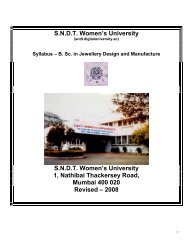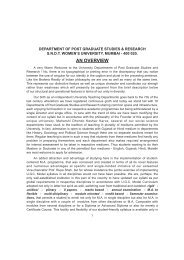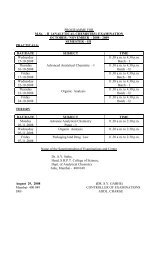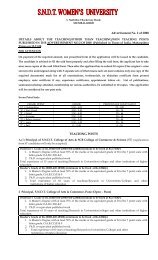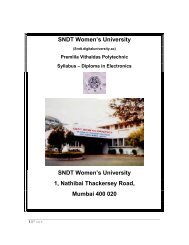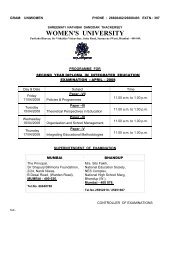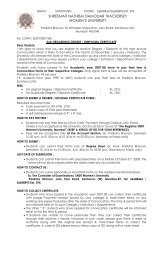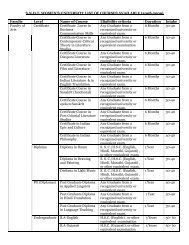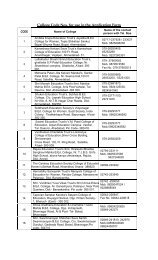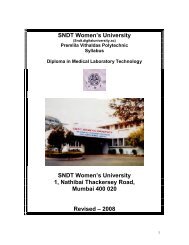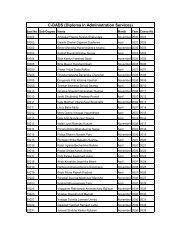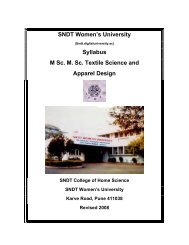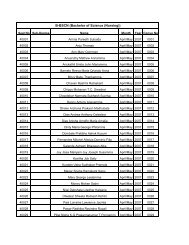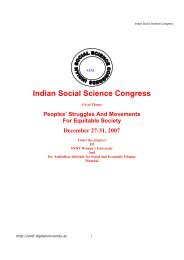Textile Science and Apparel Design
Textile Science and Apparel Design
Textile Science and Apparel Design
Create successful ePaper yourself
Turn your PDF publications into a flip-book with our unique Google optimized e-Paper software.
SDT Women’s University(Sndt.digitaluniversity.ac)Syllabus – B. Sc.<strong>Textile</strong> <strong>Science</strong> <strong>and</strong> <strong>Apparel</strong> <strong>Design</strong>SDT Women’s University1, athibai Thackersey Road,Mumbai 400 020Revised – 20081 | P a g e
Eligibility: : XIIth st<strong>and</strong>ard from any recognized BoardObjectives:1. To impart knowledge about <strong>Textile</strong>s <strong>Science</strong> <strong>and</strong> <strong>Apparel</strong> <strong>Design</strong>.2. To develop skills for professional opportunities in <strong>Textile</strong> <strong>Science</strong> <strong>and</strong> <strong>Apparel</strong><strong>Design</strong>3. To enable students to develop necessary entrepreneurial skills.SCHEME: Semester Io. Subjects L CrP/T TPD/wk FinalInternal P/V T1 English 3 4 2 2.5 75 25 - 1002 Applied <strong>Science</strong> I (Th) 4 4 - 2.5 75 25 - 1003 Applied <strong>Science</strong> I (Pr) - 2 4 - - 25 25 504 Entrepreneurship (Pr) - 2 4 - - 50 - 505 Life Span Development 4 4 - 2.5 75 25 - 1006<strong>Textile</strong> <strong>Science</strong> & <strong>Apparel</strong><strong>Design</strong> (Th)4 4 - 2.5 75 25 - 1007<strong>Textile</strong> <strong>Science</strong> & <strong>Apparel</strong><strong>Design</strong> (Pr)- 2 4 - - 25 25 50Total 15 22 14 10 300 200 50 550SCHEME: Semester IIo. Subjects L CrP/T TPD/wk FinalInternal P/V T1 English 3 4 2 2.5 75 25 - 1002Physiology & ReproductiveHealth (Th)4 4 - 2.5 75 25 - 1003Physiology & ReproductiveHealth (Pr)- 1 2 - - 25 - 254Nutrition & Food <strong>Science</strong>(Th)4 4 - 2.5 75 25 - 1005Nutrition & Food <strong>Science</strong>(Pr)- 2 4 - - 25 25 506 Resource Management 4 4 - 2.5 75 25 - 1007 Environment Studies 4 4 - 2.5 75 25 - 100Total 19 23 08 12.5 375 175 25 5752 | P a g e
SCHEME: Semester IIIo. Subjects L Cr P/T/wk1Current Concerns &44Women’s Studies2Extension for Development44-I3Nutrition for Life Span44(Th)DTPFinalInternal P/V T- 2.5 75 25 - 100- 2.5 75 25 - 100- 2.5 75 25 - 1004 Nutrition for Life Span (Pr) - 2 4 - - 25 25 505Art <strong>Design</strong> &44Aesthetics(Th)- 2.5 75 25 - 1006Art <strong>Design</strong> & Aesthetics2-(Pr)4 - - 25 25 507 Culinary <strong>Science</strong> (Pr) - 2 4 - - - 50 50Total 16 22 12 10 300 150 100 550SCHEME: Semester IVo. Subjects L CrP/T TPD/wk FinalInternal P/V T1 Family Dynamics 4 4 - 2.5 75 25 - 1002Extension forDevelopment-II (Pr)- 2 4 - - 50 - 503Fabric Ornamentation &Accessory <strong>Design</strong>ing- 2 4 - - 25 25 504 <strong>Textile</strong> <strong>Science</strong> (Th) 4 4 - 2.5 75 25 - 1005 <strong>Textile</strong> <strong>Science</strong> (Pr) - 2 4 - - 25 25 506 Basic Fashion Illustration - 2 4 - - 25 25 507 Basics of Pattern Making - 2 4 - - 25 25 508 Garment Grading - 2 4 - - 25 25 509Information Technology in<strong>Textile</strong> <strong>Science</strong> & <strong>Apparel</strong> - 2 4 - - 50 - 50<strong>Design</strong>Total 08 22 28 05 150 275 125 5503 | P a g e
SCHEME: Semester Vo. Subjects L CrP/T/wkDTPFinalInternal P/V T1Traditional <strong>Textile</strong>s &Embroideries of India4 4 - 2.5 75 25 - 1002<strong>Textile</strong> Chemistry & WetProcessing (Th)4 4 - 2.5 75 25 - 1003<strong>Textile</strong> Chemistry & WetProcessing (Pr)- 2 4 - - 25 25 504 Fashion <strong>Apparel</strong> <strong>Design</strong> - 4 8 - - 50 50 1005Principles of Management& Marketing4 4 - 2.5 75 25 - 1006Garment ProductionManagement- 2 4 - - 25 25 507Resent advances in <strong>Textile</strong><strong>Science</strong> & <strong>Apparel</strong> <strong>Design</strong>- 2 4 - - 50 - 50Total 12 22 20 7.5 225 225 100 550SCHEME: Semester VIo. Subjects L CrP/T/wkDTPFinalInternal P/V T1<strong>Textile</strong> & Garment QualityControl(Th)4 4 - 2.5 75 25 - 1002<strong>Textile</strong> & Garment QualityControl(Pr)- 2 4 - - 25 25 503 Fabric Manufacture(Th) 4 4 - 2.5 75 25 - 1004 Fabric Manufacture(Pr) - 2 4 - - 25 25 505Fundamentals of <strong>Apparel</strong>Merch<strong>and</strong>izing4 4 - 2.5 75 25 - 1006 Theory of Knitting 4 4 - 2.5 75 25 - 1007Professional application in<strong>Textile</strong> <strong>Science</strong> & <strong>Apparel</strong><strong>Design</strong>- 2 4 - - - 50 50Total 16 22 12 10 300 150 100 550L= o. of Lectures/week, P/T=Practical/ Tutorial in hrs, D= Duration of Theory paperfor Examination in hrs, TP= Theory Paper- marks, Internal= Term Work- Marks,P/V= Practical/ Viva Voce- marks, T= Total4 | P a g e
Communication Skills In English(Higher Level)This paper may be offered at Semester I <strong>and</strong> II to students who have studied throughthe English medium at school until St<strong>and</strong>ard X <strong>and</strong> have a fair level of competence inthe subject.Objectives:1. To enable students to participate independently in conversations <strong>and</strong> discussionsconducted in English.2. To familiarize students with basic letter patterns.3. To train the students in report writing <strong>and</strong> presentation of the same.4. To train the students in reading skills such as skimming, scanning <strong>and</strong> drawinginference from a text.5. To enable students to read literary text with underst<strong>and</strong>ing <strong>and</strong> enjoyment.TheorySubject L Cr P/T D TP Internal P/V TCommunication Skills in English(Higher Level)Contents:Blocko.Topics <strong>and</strong> Details4 4 - 2.5 75 25 - 100o. ofLecturesWeightagein %1 Basics of Good Communication Skills 01 -2 Reading <strong>and</strong> Study SkillsUnit 1: Skimming/ScanningUnit 2: Note makingUnit 3: Comprehension SkillsUnit 4: Reading a passage with intonation<strong>and</strong> voice modulation3 Report Writing (1)Unit 1: Basics of good reportingUnit 2: Reporting an eventUnit 3: Writing minutes of a meeting4 Four Basic Letter PatternsUnit 1: Application lettersUnit 2: Regret letters06 1505 1510 205 | P a g e
Unit 3: Appeal/Request lettersUnit 4: Complaint letters5 Summarizing/Précis Writing 04 106 Conventions of ConversationUnit 1: EtiquetteUnit 2: Asking questions/making suggestionsetc.Unit 3: Writing a dialogue <strong>and</strong> role play7 Literary Appreciation of Stories 1 – 8from the Prescribed Text ‘Let’s GoHome <strong>and</strong> Other Stories’Unit 1: Critical responses to stories/Expressing personal responsesUnit 2: Reference to contextUnit 3: Vocabulary buildingQuestion paper will be set with internaloptions8 Practical Sessions for Reading/Writing<strong>and</strong> Verbal Skills to be conducted inTutorials04 1016 30(15)(10)(5)14Prescribed Texts:The first 8 stories from the book Let’s Go Home <strong>and</strong> Other Stories (Ed.), MeenakshiMukherjee, Orient Longman Private Ltd.Tasks selected from Interface: A textbook of Compulsory English by Dr Ranu Vanikar <strong>and</strong> DrKatayun Palia, Vikas Publishing House Ltd.Email: orders@vikas.gobookshopping.comWebsite: www.gobookshopping.comEvaluation:1. One written paper (unit test) of 25 marks2. Continuous assessment of oral/verbal skills for 25 marks3. Final (external) examination of 75 marks at college level4. Total marks -Internal 25 + External 75 = 1006 | P a g e
Communication Skills In English( Lower Level)This course is offered at Semester I <strong>and</strong> II for students who have studied through thenon- English medium at school until St<strong>and</strong>ard ten. It may also be offered to thosestudents who have studied in English medium but who do not have sufficient languageproficiency for the Home <strong>Science</strong> course.Objectives:1. To enable students to participate independently in conversations <strong>and</strong> discussionsconducted in English.2. To familiarize students with basic letter patterns.3. To train the students in report writing <strong>and</strong> presentation of the same.4. To train the students in reading skills such as skimming, scanning <strong>and</strong> drawinginference from a text.5. To enable students to read literary text with underst<strong>and</strong>ing <strong>and</strong> enjoyment.Subject L Cr P/T D TP Internal P/V TCommunication Skills InEnglish( Lower Level)4 4 - 2.5 75 25 - 100Contents:Blocko.Topics <strong>and</strong> Detailso. ofLecturesWeightagein %1 Basics of Good Communication Skills 01 -2 Reading <strong>and</strong> Study skillsUnit 1: Skimming/ScanningUnit 2: Note makingUnit 3: Comprehension SkillsUnit 4: Reading a passage with intonation <strong>and</strong> voicemodulation3 Remedial grammar <strong>and</strong> vocabulary building :(prepositions, use of articles, conjugation of verbs,use of tenses, antonyms, synonyms, homonyms etc)06 1508 154 Paragraph writing/Short compositions 05 107 | P a g e
5 Conversation skills <strong>and</strong> EtiquetteUnit 1: How to ask questionsUnit 2: Introducing one self/breaking the iceUnit 3: How to give suggestionsUnit 4: Situational dialogue writing <strong>and</strong> role play06 106 Giving Instructions/Directions 02 107 Semi-official letters:Unit 1: AppealUnit 2: ApologyUnit 3: invitationUnit 4: congratulations/condolence8 Literary Appreciation of all stories fromprescribed text Yuva Katha part 4Unit 1: Expressing personal responsesUnit 2: Vocabulary buildingQuestions will be set with internal options9 Practice sessions for reading/writing <strong>and</strong> verbalskills to be conducted in tutorials06 2012 2014Prescribed Texts:Yuvakatha Part 4. (Ed.) Geeta Dharmarajan. Books are available at Katha Building Centre,Sarai Kal Khan, Nizmuddin East, Delhi- 110 013Appropriate tasks from A Remedial Course in English for Colleges (Book II). CIEFL, OUP<strong>and</strong> Interface. A textbook of Compulsory English by Dr Ranu Vanikar <strong>and</strong> Dr KatayunPalia, Vikas Publishing House Ltd.Email: orders@vikas.gobookshopping.comWebsite: www.gobookshopping.comEvaluation:1. One written paper (unit test) of 25 marks2. Continuous assessment of oral/verbal skills for 25 marks3. Final (external) examination of 75 marks at college level4. Total marks -Internal 25 + External 75 = 1008 | P a g e
Applied <strong>Science</strong>(Theory)Objectives-1) To inculcate scientific temper in the students <strong>and</strong> develop scientific attitude.2) To acquire basic knowledge of various biological processes.3) To acquaint the students with fundamentals of Physical <strong>Science</strong>s enabling them Toapply in day To day life.4) To help the students to underst<strong>and</strong> importance of Chemistry <strong>and</strong> Physics with respectTo food, textile, medicine, agriculture <strong>and</strong> industries.5) To impart knowledge of applications of biological process in day To day life.Subject L Cr P/T D TP Internal P/V TApplied <strong>Science</strong> (Theory) 4 4 - 2.5 75 25 - 100Contents;Sr.o.Topic <strong>and</strong> Details1 Revision of Basic Chemistry2 Introduction To Polymers <strong>and</strong> Their ApplicationUnit 1: Introduction, Monomeric Unit, Polymerisation-Addition, Condensation, Classification- Natural <strong>and</strong>Synthetic, Organic <strong>and</strong> Inorganic, Thermoplastic <strong>and</strong>Thermosetting, Functionality of monomers withillustrations.Unit 2: Some important polymers <strong>and</strong> their uses. ManmadePolymers- Polythylene, Polypropylene, PolyvinylChloride.3 Perfumes And CosmeticsUnit 1: Perfumes- General, Formulation- Emulsifier solid.Sources of perfumes- plant oils, flower oils, animalsecretions, <strong>and</strong> chemical substances (eg. Khus,S<strong>and</strong>alwood, Eucalyptus, Rose, Jasmin, Orange, Nutmeg)<strong>and</strong> uses.Unit 2: Cosmetic Products:- Definition, skin cream <strong>and</strong>lotions, General, Formulation4 DyesUnit 1: Definition, chromophore, auxochrome,classification based on application.Unit 2: Uses of dyes of foods, textiles, medicine, cosmetics,o. of %WeightageLectures0304 805 602 69 | P a g e
industries <strong>and</strong> their hazards.5 Drugs <strong>and</strong> PharmaceuticalsUnit 1: Introduction To common drugs, properties of drugs.Unit 2: Common drugs: Meaning of terms with oneexample- Analgesic, antacid, antibiotics, antiinflammatory,diuretics, laxatives, sulfa drugs.Unit 3: Mode of action (in brief) uses <strong>and</strong> hazards ofAspirin, Paracetamol, Sulphanilamide.6 Soaps <strong>and</strong> DetergentsUnit 1: Chemistry of soaps <strong>and</strong> detergents.7 Red Listed ChemicalsUnit 1: Red listed chemicals used in day To day life <strong>and</strong>possible routes of contamination.Introduction, types, hazards- Food additives(synthetic) - artificial sweeteners, preservatives <strong>and</strong>stabilizers of food. Agrochemicals- Insecticides, pesticides.8 CellUnit 1: Introduction To cell, types of cell (Eukaryotes,Prokaryotes) their general characteristics with examples.Unit 2: Ultra microscopic structures of animal cell. Cellorganelles, their structure <strong>and</strong> functions.Unit 3: Types of cell division. MiTosis <strong>and</strong> Meiosis. (briefintroduction)Significance of each type of cell division.9 Introduction To Micro-organismIntroduction, General Characteristics, Important classes <strong>and</strong>Examples of each group for the following micro-organismsUnit 1: BacteriaUnit 2: AlgaeUnit 3: FungiUnit 4: ProTozoaUnit 5: Virus10 Genetics <strong>and</strong> HeredityUnit 1: Mendel’s laws- Monohybrid <strong>and</strong> Dihybrid crossUnit 2: Structure of DNA <strong>and</strong> types of RNAUnit 3: Protein SynthesisUnit 4: MutationUnit 5: Chromosomes <strong>and</strong> their structure- auTosomes <strong>and</strong>06 1403 604 605 1005 1409 1410 | P a g e
sex chromosomes. Abnormality due To chromosomesnumberUnit 6: Sex determination in Human beings, sex linkeddiseases (Hemophilia <strong>and</strong> color blindness)11 Genetic Engineering <strong>and</strong> BiotechnologyUnit 1: Introduction To Biotechnology <strong>and</strong> GeneticEngineeringUnit 2: Gene Cloning-Introduction <strong>and</strong> methodology inbrief.Unit 3: Applications of Genetic Engineering in plants-Insects <strong>and</strong> virus resistant plants. Plants with improvedcharacters (in brief)Unit 4: Applications of Genetic Engineering in HumanMedicine <strong>and</strong> Pharmaceuticals-Thallessemia, Oncogenes, Interferon, production of growthhormones <strong>and</strong> Human insulin. (in brief)12 ImmunologyUnit 1: Introduction To Immune system <strong>and</strong> types ofimmunityUnit 2: Antigen <strong>and</strong> antibody reactions <strong>and</strong> their assays{in brief)07 1003 6References-1. Gowarikar V.R., Viswanathan N.N., Jaydev S. (1990): Polymer <strong>Science</strong>- WileyEastern Ltd.2. Shrma P.P. (1998): Cosmetics- Formulation, Manufacturing <strong>and</strong> Quality Control,V<strong>and</strong>ana Publications, Delhi.3. Poucher W.A.: Perfumes, Cosmetics <strong>and</strong> soaps (Vol. I <strong>and</strong> II)4. Robert I.E.: Cosmetic Ingredients- Their safety assessment, PathoTox Publishers,Inc.5. Synthetic Dyes by Dr. Venkatraman Vol.I6. Prof. V.A. Shenal (1991): Introduction To the Chemistry of Dyestuffs, SevakPublications.7. Dr. H.P. Tipnis, Dr. A.S.Dhake (1999): Pharmaceutical Chemistry-II, VrindaPublications, M.G. Road, Jalgaon.8. Kent S.A> (1974): Riegel’s H<strong>and</strong>book of Industrial Chemistry.9. Pearson D. (1983): The Chemical Analysis of Foods, Churchill LivingsTone,Edunburgh, London, New York.10. Zhdanov L.S.: Physics for the Techician, MIR Publications. Moscow.11. Thomsen E.G.: Modern Cosmetics.12. Shiv Narayan Sahu: Preparation <strong>and</strong> distribution of drugs <strong>and</strong> cosmetics.13. Organic Chemistry, Finar Vol. I14. Organic Chemistry, Finar Vol. II15. George A. (1984): Shreev’s Chemical Process Industries.11 | P a g e
12 | P a g e16. Avery M.: Household Physics, The Macmillin Co.17. Loewy A. <strong>and</strong> Sckevilz (1995): Cell Structure <strong>and</strong> Functions, Hold New York.18. Porter K.R., Bonneville M.A.: Fine structure cells <strong>and</strong> tissues.19. Nicholl D.S.T.(1994): An introduction To Genetic Engineering- CambridgeUniversity Press.20. Rao C.V. (1994): Foundation To Mol Bool, R.Chenda Co.Publishers.21. Pelczar N.J., Chan F.C.S., Krieg N.R. (1998): Microbiology, Tata McGraw Hill22. Stanier R.Y., Ingraham J.L., Whekle M.L., Panler P.R.(1992): GeneralMicrobiology, Mcmillan Education Ltd.23. Glazer A.N. & Nikaido H.(1995) Microbial Biotechnology W.H. FreemanCompany.24. Rangaswami G. & Bagy D.J.(1993) Agricultural Microbiology <strong>and</strong> Prentice Hallof India Private Ltd.25. Winchester A.M.: Genetics, Oxford & IBH Publishing home.26. Lehninger: Principles of Biochemistry, C.B.S. Publishers <strong>and</strong> DistribuTor,Bholanath Nagar, Shahdra, Delhi/27. Kumball J.W. (1990): Introduction To immunology, Mcmillan Publishing Co.28. Coleman R.M., Lombard M.F. <strong>and</strong> Sicord R.E. (1992): FundamentalImmunology, W.C.Brown Publishers.
Applied <strong>Science</strong>(Practical)Objectives:1) To develop in students the ability to work systematically in laboratory2) To develop in them the skill for simple chemical procedures.3) To acquire knowledge of various micro organisms <strong>and</strong> develop required skills for thestudy of micro organisms.Subject L Cr P/T D TP Internal P/V TApplied <strong>Science</strong> (Practical) - 2 4 - - 50 - 50BlockoTopic <strong>and</strong> Details1 Introduction to Chemistry Lab. Apparatus2 Acid Base Titrationo. ofperiods0408Neutralization of strong acid with strong baseNeutralization of weak base with strong acid3. pH determination of various solutionsAcid, Base <strong>and</strong> Neutral (two household examples for each)4. Viscosity MeasurementWater, Oil, Shampoo by Oswald's Viscometer.5. Study <strong>and</strong> care of Microscope6. Observation of motility of Bacteria byhanging drop method (E. coli <strong>and</strong> Proteus)7. Observation of bacteria by the simplemonochrome staining method (Hay infusion culture or milk)8. Gramstain of bacteria in milk04040406060613 | P a g e
9.To observe common pathogenic bacteria (any6- Permanent slides)0410. Observation of fungi on different food material <strong>and</strong> culture (PDAmedium)11. To observe common pathogenic protozoa (Permanent slides ofentamoeba histolitica <strong>and</strong>plasmodium vivex020212. Study of medicinally important plants (project) 0214 | P a g e
Life Span DevelopmentObjectives:This course will enable students to:1. To develop an underst<strong>and</strong>ing of human behaviour.2. To become acquainted with the developmental stages from birth to old age.3. To develop awareness of important aspects of development during the whole lifespan.4. To underst<strong>and</strong> the problems faced by an individual throughout the life span.Theory:Subject L Cr P/T D TP Internal P/V TLife span Development 4 4 - 2.5 75 25 - 100Contents:Blocko.1 IntroductionTopics <strong>and</strong> DetailsUnit 1: Meaning of Life Span Development <strong>and</strong> needto study development through the life courseUnit 2: Life span development - a multidisciplinaryapproachUnit 3: Psychology- A science of underst<strong>and</strong>ing humanbehaviourDefinition <strong>and</strong> scope of psychologyo. ofLectures%Weightage5 82 The Dynamics of BehaviourUnit 1: Meaning of behaviour, Individual differenceUnit 2: Motivation <strong>and</strong> needs, definition, theories,typesUnit 3:Frustration <strong>and</strong> conflict - definition, sources,effects of frustration, adjustment to frustration3 Introduction to Periods in Lifespan DevelopmentUnit 1: Different periods in lifespan developmentUnit 2: Inter relationship between the aspects ofdevelopmentUnit 3: Historical perspectives8 142 515 | P a g e
4 Prenatal <strong>and</strong> InfancyUnit 1: Overview of prenatal stageUnit 2: Definition, Physical growth <strong>and</strong> development ininfancy (reflexes, emotional states, Physicalgrowth & motor development, brain).Unit 3: Developmental tasks of infancy, mile-stones &highlights of development5 Early Childhood Period (2 to 6 years)Unit 1: Definition, overview of early childhood years,highlights, developmental tasks, milestonesUnit 2: Nursery school - Orientation to nursery school& significanceVisit to nursery schoolUnit 3: Importance of play for all round development.(students to prepare one play material)6 Middle Childhood (6 to 9 years)Unit 1: a) Definition (b) Developmental tasksUnit 2: School – its significance & importance, effectsof success & failureUnit 3: Peer group - importance & significance,functions7 Adolescence (9 to 20 years)Unit 1: Definition, period of storm & stressUnit 2: Physical development – puberty, growth spurt,primary & secondary sex characteristics, early& late maturationUnit 3: SocializationUnit 4: Choosing career – Stages <strong>and</strong> factors affectingchoice8 Young Adulthood (21 to 40 years)Unit 1: Definition of an “Adult”, need to studyUnit 2: Developmental tasks of a young adultsignificance of the period responsibilities <strong>and</strong>adjustment: New family, work place,parenthood, independence, financial matters5 58 88 128 126 1516 | P a g e
9 Middle Adulthood (41 to 60 years)Unit 1: Definition, Physical changes (senses, diseases)Menopause, Health issues10 Late Adulthood <strong>and</strong> Aging (61 years <strong>and</strong> above)Unit 1: DefinitionUnit 2: Physiological changes, <strong>and</strong> health problemsUnit3: SocializationUnit 4: Death: Preparation & coping strategies5 125 4References:1. Dave, I. (1991) “The basic essential of counseling”, Sterling Publisher Pvt. Ltd.2. Fuster, J.M. (1988) “Personal counseling: Better yourself book”.3. Gelso, C. <strong>and</strong> Fretz, B. (1995) “Counselling psychology”, William James CentennialSeries.4. Madhukar, I. (2000) “Guidance <strong>and</strong> Counselling”, Authors Press.5. Rao, S.N. (1991) “Counselling <strong>and</strong> Guidance”, Tata McGraw Hill PublishingCompany Limited, New Delhi.6. Satya, B.N. (2002) “Guidance <strong>and</strong> Counselling”, Abhishek Publication, Ch<strong>and</strong>igarh.7. Shankar, L. (1993) “Guidance, Educational, Vocational, Personal <strong>and</strong> Society”,Enkay Publisher Pvt. Ltd.8. Singh, R. (1994) “Educational <strong>and</strong> Vocational Guidance”, Common wealth Publisher,New Delhi.Internal Assessment:Simulation exercise for counselling processRole play: Counselling skills <strong>and</strong> attitude - 15 marksUnit tests- 10 marks17 | P a g e
<strong>Textile</strong> <strong>Science</strong> & <strong>Apparel</strong> <strong>Design</strong>( Theory)Objectives:1) Students gain knowledge of nomenclature <strong>and</strong> classification of Fibres, yarns, <strong>and</strong>fabrics in pure <strong>and</strong> blended form.2) To teach general principles of clothing construction, selection, use <strong>and</strong> scope.3) To make the students wise <strong>and</strong> responsible consumer with good values.4) To provide information related to legislation, labelling, <strong>and</strong> st<strong>and</strong>ards to enhance theconsumer’s underst<strong>and</strong>ing of textiles <strong>and</strong> clothing.5) To gain the basic knowledge of costing.Subject L Cr P/T D TP Internal P/V T<strong>Textile</strong> <strong>Science</strong> & <strong>Apparel</strong><strong>Design</strong> ( Theory)Contents:4 4 - 2.5 75 25 - 100Block /Unit Topic o. of Marksperiods1 Introduction To <strong>Textile</strong>sUnit : 1 Scope of textiles, general properties <strong>and</strong>classification of textile fibres by <strong>Textile</strong> Fibre ProductIdentification Act. Concept of green fibres & Ecofriendly textiles.(in brief)8 152 Yarn ConstructionUnit : 1Concept of yarn spinning.10 10Unit : 2Types of yarns-single, ply, cable & cord, &texturized yarns.Unit : 3 Novelty yarns – Nub, slub, Ratine, Boucle,Corkscrew, Chenille3 Fabric ConstructionUnit : 1 Introduction to fabric construction & basicweaves.(concept of weaving, knitting <strong>and</strong> non wovento be explained.Unit : 2Definition, terms <strong>and</strong> uses of 25 fabrics namely –For Personal Clothinglawn,poplin, cambric, 2 x 2, org<strong>and</strong>y, voile, denim,drill, seer sucker, jute, khadi & other h<strong>and</strong>loomfabrics.Home <strong>Textile</strong>scasement,terrycloth, jacquard, cut pile, knitted,bonded, laminated, embossed, linenFashion Fabrics-Satin, tissue, crape, georgette, chiffon,knitted, knotted,braided, narrow fabrics,wrinkled, brasso, suede11 2018 | P a g e
Unit : 3 Definitions, uses, advantages <strong>and</strong>disadvantages of unions & blends.4 Introduction To <strong>Apparel</strong> <strong>Design</strong>Unit: 1 Scope <strong>and</strong> importance of clothing.Unit: 2 Principles & elements of design in relation toapparel design.Unit: 3Anthropometry & Human Anatomy, Body size& body measurements.(in brief)Unit: 4 Aesthetics of Personality & Clothing. -exercise, care of hair, complexion, eating & sleepinghabits, posture, gait, charm, manners.5 Aesthetic And Functional Performance Of FabricAnd Ready To Wear Garments Or <strong>Apparel</strong>Unit: 1 Personal clothing- sports (Indoor & Outdoor),casual, spectator clothes – selection, use <strong>and</strong> care.Unit: 2Situational clothes – corporate, occasional,seasonal, age-wise (Infant to old age).Unit: 3 Buying points for ready made garments – size,suitability, durability, aesthetic appeal, fibre content,labels (basic information & care labels), br<strong>and</strong>,purchasing power, socio economic – conditions,location etc.Unit: 4Selection of clothing according to personalitytypes.6 St<strong>and</strong>ardsUnit: 1 <strong>Textile</strong> Performance Legislation Acts – Bureau of Indian St<strong>and</strong>ards Flammable Fabrics Act Care labelling Act & Type of labelling. Wool labelling Act. Eco labelling. Silk Mark H<strong>and</strong>loom Mark10 1510 206 107 Costing 5 10Evaluation:(1) Two unit tests of 25 mark each. Average of that should be taken as internal marks.(2) Final (external) examination of 75 marks at college level.(3) Total marks -Internal 25 + External 75 = 100References:1 Bane A : Creative clothing Construction, New York: Mc Graw hill Book Co.,1956.19 | P a g e
2 Brown Rice, Ready to Wear <strong>Apparel</strong> Analysis, 2 nd edition, Prentices Hall, 19983 Carson : How you look to dress, St.L0uis. Mc Graw Hill, 1969.4 Doongaji S. & Deshp<strong>and</strong>e R.: Basic Processes & Clothing Construction.5 Edward Miller : <strong>Textile</strong>s : properties & behaviour in clothing use, London: B.T.Bradsford, 1992.6 Gin Stiphens Frings, Fashion from Concept to Consumer 7 th Ed New JerayPrentice Hall Inc 20027 Gohl E.P. <strong>and</strong> Velensky L.D. : <strong>Textile</strong> <strong>Science</strong>, Melborne: Longman CheshirePvt.Ltd.,1983.8 H<strong>and</strong>books of American Association of Home Economics.9 Hollan, Norma & Saddler – <strong>Textile</strong>s, 16th Edition, New York, Macmillanpublishing Co, 199810 Joseph M. – Essentials of <strong>Textile</strong>s - Holt, Rinehart & Winston, New York, 1976.11 Joseph M. – Introductory <strong>Textile</strong> <strong>Science</strong>. – 6 th Ed., Fort Worth Harcourt BraceJovanovich College Publishers. 199312 Khadi, The fabric of freedom, Amr Vastra Kosh Trust Publication 2002.13 Kefgan & Phyllis T.: Specht & Mac Million publication, Individuality in clothingSelection & Personal Appearance – a guide for the consumer, Upper Saddle River,Prentice Hall Inc., 2000.14 Lyle Dorothy : Performance of <strong>Textile</strong> for Testing, New York: John Wiley &Sons,1977.15 Mabel D.E. & A.K. : Clothing for Mordens , 3 rd edition, New York: Mac Millionpublication.16 Mary Kefgen, Phyllis Touchie – Specht : Individuality in Clothing selectionAnd Personal Appearance: Guide for the consumer.(5 th Ed) Lipper Saddle River ,Prentice Hall Inc , 200017 Mary R.S.: Clothing – A study in Human Behaviour.18 Mc. Jimsey : Art in clothing selection, New York: Harper & Row, 196319 Potter & Corbman : <strong>Textile</strong> – Fibre to Fabric, 6 th edition, New York: Mc Graw hillBook Co., 1983.20 Reader’s Digest: Complete guide to sewing, New York: The Reader’s DigestAssociation, 1976.21 Ruth E Glock, Grace Kunz – <strong>Apparel</strong> Manufacture Sewn Product Analysis,Macmillan, 3 rd Ed New Jercy Prentice Hall Inc, 200022 Stout E : Introduction to <strong>Textile</strong>s, New York: John Wiley & Sons,197023 Tate & Glisson : Family Clothing, New York: John Wiley, 1961.24 Tortora, Phyllis G. – Underst<strong>and</strong>ing <strong>Textile</strong>s – Upper Saddle River, MerillPublishing – 5 th Edition. Prentice Hall Inc, 198525 Virginia Stolpe Lewis – Comparative Clothing Construction Technique, Delhi :Surjeet Publications , 198426 Wingate I.B., Mohler J.F. – <strong>Textile</strong> Fabrics <strong>and</strong> their selection (8 th Ed.)Engle woodcliffe27 Wingate Isable B.: Fairchild’s Dictionary, 6 th edition, New Delhi: Universal Pub.Corporation, 1988.28 Wynne A. – <strong>Textile</strong>s – motivates series, London , Macmillan Education Ltd. 199720 | P a g e
Entrepreneurship(Practicals)Objectives:1. To underst<strong>and</strong> the concept of entrepreneurship2 .To know the world of entrepreneurs3. To underst<strong>and</strong> <strong>and</strong> cultivate entrepreneurial values, attitude, qualities <strong>and</strong> Desires.4. To sow the seed of entrepreneurship in fertile mindsSubject L Cr P/T D TP Int P/V TEntrepreneurship (Pr) - 2 4 - - 25 25 50Contents:Block.Topic <strong>and</strong> Detailso. of %WeightageoLectures1 Introduction to Entrepreneurship: 4 5Unit 1- Definition, Concept <strong>and</strong> Need for entrepreneurship.Unit 2- Types of entrepreneurs: Spontaneous, Motivated <strong>and</strong>Induced.(Teachers to explain <strong>and</strong> discuss case studies in class <strong>and</strong> invitedifferent types of entrepreneurs to share the reasons <strong>and</strong> causesto entrepreneurship as a profession)Unit 3- Kinds of Entrepreneurship: Proprietary, Partnership <strong>and</strong>Group Entrepreneurship.(Teachers to explain <strong>and</strong> discuss case studies in class <strong>and</strong> invitedifferent kinds of entrepreneursto share their experiences <strong>and</strong> talk about the advantages <strong>and</strong>disadvantages of proprietarypartnership <strong>and</strong> group enterprises)2 Exploring the World of Entrepreneurs: 8 10Unit 1- Legendary, Business, Social <strong>and</strong> Environmental,Artistic <strong>and</strong> Aesthetic Entrepreneurs (Students to Documentcase studies <strong>and</strong> present using different audiovisual aids, maybe individual or group activity)Unit 2- Entrepreneurs in Shadows, failedentrepreneurship(Students to Document case studies <strong>and</strong>present using different audiovisual aids, may be individual orgroup activity)Unit 3- New Internet Entrepreneurs. (Students to Documentcase studies <strong>and</strong> present using different audiovisual aids, maybe individual or group activity)3 Entrepreneurial Assets 8 15Unit 1- Entrepreneurial Values <strong>and</strong> attitudes.Unit 2- Entrepreneurial Qualities.Unit 3- Role dem<strong>and</strong>s <strong>and</strong> Requirements of Entrepreneurs.Unit 4- Barriers to entrepreneurship.(Teachers to discuss <strong>and</strong> expose students to entrepreneurs toshare their views <strong>and</strong> importance they give to particularentrepreneurial values, attitudes, qualities, role dem<strong>and</strong>s,requirements <strong>and</strong> Barriers)4 Entrepreneurial Motivation 4 1521 | P a g e
Unit 1- Definition <strong>and</strong> Meaning of Achievement Motivation.Unit 2- Need for Achievement MotivationUnit 3- Motivating Factors: Internal <strong>and</strong> External.(Teachers toexplain with examples)5 Gaining Personal Focus <strong>and</strong> Developing Skills 20 20Unit 1- Communication Skills: Written <strong>and</strong> verbalcommunication.Unit 2- Barriers to communication.Unit 3- Developing Listening skills.(Teachers to explain the do’s <strong>and</strong> don’ts of communication.Students to practice written <strong>and</strong> spoken office communication.Unit 3- Personality Development: experts in the field to takesessions with students.Unit 4- Gaining Personal Focus: Defining ones own Intentions,goals <strong>and</strong> purpose.Internal Intentions: (Students to share what her business willaccomplish for her in her life, like prestige, economicindependence etc. etc.External Intentions: (Students to describe how <strong>and</strong> who thebusiness will help.6 Entrepreneurial Ideas 8 20Unit 1- Creativity <strong>and</strong> Idea GenerationUnit 2- Searching <strong>and</strong> selecting Entrepreneurial Ideas.Unit 3-Dynamics of project Identification.Unit 4- Matching Project <strong>and</strong> enterprise.(Teachers to guide students)Unit 5- Gather Information on what works, How to succeed<strong>and</strong> Mistakes to avoid.(Students to interact with particular business persons related totheir identified project/ field of interest, have Brainstormingsessions <strong>and</strong> share Ideas <strong>and</strong> Strategies in class)Unit 6 - Research select articles written about the industryrelated to their product or service.7 Organize Visits to Industries <strong>and</strong> Organisations helpingentrepreneurship.8 15References:1. Bolton, B. & Thompson, J (2001): Entrepreneurs: Talent, Temperament, Technique,Replika Press Private Ltd, Delhi, 110 040, India.2. Taneja, S. & Gupta, S.L. (1992) Entrepreneurship Development, New VentureCreation, Galgotia Publishing Company, New Delhi.3. Hisrich, R.D. & Peters, M.P. (1995) Entrepreneurship: Starting, Developing <strong>and</strong>Managing a New Enterprise, Richard, D. USA, Irwin, INC.4. Desai, V. (1991, 97, 99, Vol I & II,) Entrepreneurial Development, Himalaya Publishing House.Mumbai.22 | P a g e
SEMESTER IICommunication Skills In English(Higher Level)This paper may be offered at Semester I <strong>and</strong> II to students who have studied throughthe English medium at school until St<strong>and</strong>ard X <strong>and</strong> have a fair level of competence inthe subject.Objectives:1. To enable students to participate independently in conversations <strong>and</strong> discussionsconducted in English.2. To familiarize students with basic letter patterns.3. To train the students in report writing <strong>and</strong> presentation of the same.4. To train the students in reading skills such as skimming, scanning <strong>and</strong> drawinginference from a text.5. To enable students to read literary text with underst<strong>and</strong>ing <strong>and</strong> enjoyment.Theory:Subject L Cr P/T D TP Internal P/V T4 4 - 2.5 75 25 - 100Communication Skills In English(Higher Level)Contents:Blocko.Topics <strong>and</strong> Detailso. ofLectures%Weightage1 Report writing (2)Unit 1: Different kinds of reports/ Structure ofreportUnit 2: Preparing a project reportPresenting a project report on a previouslyassigned topic0610152 Writing a ResumeUnit 1: How to write a ResumeUnit 2: How to write a covering letter for a jobapplicationUnit 3: Resume writing with ready made formatsavailable on computer packages06 1523 | P a g e
3 Devising a questionnaire <strong>and</strong> interpreting factsUnit 1: How to prepare a simple questionnaireUnit 2: How to interpret data from surveys, tables,graphs etc, <strong>and</strong> to present the interpretationin coherent <strong>and</strong> lucid languageUnit 3: Transfer of information from visual intoverbal4 Conventions of Social InteractionUnit 1: Dialogue writing for formal/semi-formalsituations etc.Unit 2: How to Prepare for an interviewUnit 3: Role Play/ mock interview sessions5 Literary Appreciation of stories 9 – 15 from thePrescribed Text ‘Let’s Go Home <strong>and</strong> OtherStories’Unit 1: Critical Appreciation /Expressing personalresponsesUnit 2: Reference to contextUnit 3: Vocabulary exercisesQuestion Paper will be set with internal options6 Practice sessions for reading/writing <strong>and</strong> verbalskills to be conducted in tutorials06 158 1518 30(15)(10)(5)14Prescribed Texts:The stories 9 – 15 from the book Let’s Go Home <strong>and</strong> Other Stories (Ed.), MeenakshiMukherjee, Orient Longman Private Ltd.Tasks selected from Interface: A textbook of Compulsory English by Dr Ranu Vanikar <strong>and</strong> DrKatayun Palia, Vikas Publishing House Ltd.Email: orders@vikas.gobookshopping.comWebsite: www.gobookshopping.comEvaluation:1. One written paper (unit test) of 25 marks2. Continuous assessment of oral/verbal skills for 25 marks3. Final (external) examination of 75 marks at college level4. Total marks -Internal 25 + External 75 = 10024 | P a g e
Communication Skills In English( Lower Level)This course is offered at Semester I <strong>and</strong> II for students who have studied through thenon- English medium at school until St<strong>and</strong>ard ten. It may also be offered to thosestudents who have studied in English medium but who do not have sufficient languageproficiency for the Home <strong>Science</strong> course.Objectives:1. To enable students to participate independently in conversations <strong>and</strong> discussionsconducted in English.2. To familiarize students with basic letter patterns.3. To train the students in report writing <strong>and</strong> presentation of the same.4. To train the students in reading skills such as skimming, scanning <strong>and</strong> drawinginference from a text.5. To enable students to read literary text with underst<strong>and</strong>ing <strong>and</strong> enjoyment.Subject L Cr P/T D TP Internal P/V TCommunication Skills InEnglish ( Lower Level)4 4 - 2.5 75 25 - 100Contents:Blocko.Topics <strong>and</strong> Detailso. ofLecturesWeightagein %1 Remedial grammar <strong>and</strong> vocabulary building :(prepositions, use of articles, conjugation of verbs,use of tenses, antonyms, synonyms, homonyms etc)2 Report writing (1)Unit 1: Basics of good reportingUnit 2: Reporting an eventUnit 3: Writing minutes of a meetingUnit 4: Presenting a short report3 Four basic letter patternsUnit 1: ApplicationUnit 2: RegretUnit 3: AppealUnit 4: Complaint6 156 1010 154 Paragraph writing 3 1025 | P a g e
5 Interpreting factsUnit 1: How to prepare a simple questionnaireUnit 2: How to interpret facts from tables, graphs etc.<strong>and</strong> to present the interpretation in coherent<strong>and</strong> lucid languageUnit 3: Transfer of information from visual intoverbal6 Writing a ResumeUnit 1: How to write a ResumeUnit 2: How to write a covering letter for a jobapplicationUnit 3: Resume writing with ready made formatsavailable on computer packages.7 Literary Appreciation of all stories fromprescribed text Yuva Katha part 7Unit 1: Expressing personal responsesUnit 2: Vocabulary buildingQuestions will be set with internal options8 Practice sessions for reading/writing <strong>and</strong> verbalskills to be conducted in tutorials04 1505 1512 2014Prescribed Texts:Yuvakatha Part 7. (Ed.) Keerti Ramch<strong>and</strong>ra. Books are available at Katha Building Centre,Sarai Kal Khan, Nizmuddin East, Delhi- 110 013Appropriate tasks from Reading <strong>and</strong> Study Strategies Book-I by Nirmala Belare <strong>and</strong>Interface. A textbook of Compulsory English by Dr Ranu Vanikar <strong>and</strong> Dr Katayun Palia.Vikas Publishing House Ltd.Email: orders@vikas.gobookshopping.comWebsite: www.gobookshopping.comEvaluation:1. One written paper (unit test) of 25 marks2. Continuous assessment of oral/verbal skills for 25 marks3. Final (external) examination of 75 marks at college level4. Total marks -Internal 25 + External 75 = 100Recommended Reading List for additional practice exercises :Adinarayana. L. Spoken English. Intensive practice to speak appropriately. Hyderabad,Neelkamal Publications. 2003.26 | P a g e
Aggarwala. N.K. Fun with Vocabulary. Madras. Macmillan India Ltd. 1992.Ashok Rani T & Others. English for career development. Hyderabad. Orient Longman. 1989.Banatwalla Ayesha. Writing Skills. SNDT University Press.Bellare Nirmala. Reading Strategies. Vols.1 <strong>and</strong> 2. New Delhi. OUP. 1997.Bhatia, Pravin S.R & Sheikh. A.M . Professional Communication Skills. New Delhi. S.Ch<strong>and</strong> <strong>and</strong> Co. 2003Charanjit Kaur, Business letters. Part 1 <strong>and</strong> Part 2. Bombay. Vipul Prakashan. 1993.Das, Susmita. English language <strong>and</strong> grammar. A resource book of ideas <strong>and</strong> activities forteachers. Jaipur. Mangal Deep Publications, 2004.Davidson, Eleanor. Formatting letters <strong>and</strong> reports. A computer user’s guide. New Delhi. VivaBooks Pvt. Ltd. 2004Dixon, Robert. Complete Course in English. Prentice Hall, India. New Delhi. 1996.27 | P a g e
Physiology <strong>and</strong> Reproductive Health(Theory)Objectives:1. To enable the students to underst<strong>and</strong> the basic structure <strong>and</strong> functions of human body.2. To create awareness about common diseases/ disorders affecting each system.Subject L Cr P/T D TP Internal P/V TPhysiology <strong>and</strong> Reproductive 3 3 - 2.0 50 25 - 75Health (Theory)Blocko.Topic <strong>and</strong> Detailso. ofLectures%Weightage1 Introduction:- General terms – Anatomy, Physiology,symmetrical arrangement, anatomical position,Median plane/ lateral plane, Internal/external,Superficial/ deep, Superior/ Inferior, Anterior/posterior- Basic human tissues- Introduction to human skeleton.Structure of bone <strong>and</strong> cartilage.- Classification of various types of muscles – brief2 Blood <strong>and</strong> Lymphatic system:(A) Blood:- Physical characteristics, Blood volume,Composition of plasma, functions ofplasma proteins- Red Blood cells: Formation <strong>and</strong> functions,haemoglobin, anaemia, Thalessemia.- White Blood cells: Types <strong>and</strong> functions,Importance of Haemogram, Leukaemia.- Platelets <strong>and</strong> mechanism of coagulation-Haemophilia.- Blood groups <strong>and</strong> Rh factor(B) Lymph: Lymphatic system- Spleen: Structure <strong>and</strong> functions.3 Heart:- Structure of Human Heart <strong>and</strong> its functions- Cardiac cycle- Blood Pressure- Pulse pressureCommon diseases- Anemia, Leukemia, Hypertension,Ischemic heart disease4 76 144 1028 | P a g e
4 Respiratory system:- Respiratory organs <strong>and</strong> their functions- Lung volumes <strong>and</strong> lung capacities- Factors affecting efficacy of respiration.- Common diseases- T.B., Asthma, Bronchitis,Cough, Pneumonia, Sinusitis.5 Gastro- Intestinal system:- Organs of the digestive system <strong>and</strong> their functions- Accessory organs of digestion- Liver, Gall Bladder,Pancreas- Common disorders- Dental caries, Vomiting,Diarrhoea, Constipation, Hyperacidity, piles.6 Excretory system:(A) Urinary System:- Structure <strong>and</strong> functions of organs of urinarysystem ( In brief)- Mechanism of urine formation- Common diseases- UTI <strong>and</strong> Renal stones(B) Skin:- Structure <strong>and</strong> functions- Regulation of body temperature- Common disorders- Burns, d<strong>and</strong>ruff, acne.7 ervous system:- Structure <strong>and</strong> functions of different parts of Brain- Special senses-(A) Eye- Structure <strong>and</strong> functions- Common problems- Conjunctivitis, trachoma,glaucoma, cataract(B) Ear- Structure <strong>and</strong> functions- Common problems- Deafness, Vertigo, Motionsickness.8 Endocrine system:- Listing of endocrine gl<strong>and</strong>s <strong>and</strong> Location, Functionsof Thyroid, parathyroid, adrenaline, <strong>and</strong> pituitarygl<strong>and</strong>s.5 107 146 125 83 529 | P a g e
9 Reproductive system <strong>and</strong> reproductive health:Female reproductive system:- Structure of female reproductive system.- Menstrual cycle, menarche <strong>and</strong> menopause- Fertilization- Breast: Structure <strong>and</strong> functions, Importance of breasthygiene <strong>and</strong> breast feeding.- Physiological changes in pregnancy, maternaladaptations in pregnancy.- Ante natal care.Male Reproductive system:- Structure of male reproductive system- Sex education- Contraception <strong>and</strong> Infertility- Sexually transmitted diseases- Syphilis, Gonnorhoea- AIDS8 20References:1) Guyton, A.C., Hall J.E. (1996) – Textbook of Medical Physiology (9 th Edition) –Prism Books Pvt Ltd., Bangalore.2) Concise medical Physiology - Chaudhari3) API textbook of medicine4) Textbook of Gynaecology - Datta5) Winwood (1988) - Sear’s Anatomy <strong>and</strong> Physiology for nurses- London, EdwardArnold.6) Wilson (1989) –Anatomy <strong>and</strong> Physiology in Health <strong>and</strong> illness, Edinburgh, ChurchillLivingstone.7) Chatterjee Ch<strong>and</strong>i Charan (1988) – Textbook of Medical Physiology, London, W.B.Saunder’s Co.30 | P a g e
Physiology <strong>and</strong> Reproductive Health(Practicals)OBJECTIVES:1. To utilize the knowledge learnt to administer first aid for common emergencyprocedures.2. To acquaint the students with basic principles of home nursing.Subject L Cr P/T D TP Internal P/V TPhysiology <strong>and</strong> Reproductive - 2 4 - - 50 - 50Health(Practicals)Sr. o. Topic <strong>and</strong> Details o. of Periodsassigned1 Estimation of one’s own Hemoglobin <strong>and</strong> blood group 022 - Demonstration of Peripheral smear of blood <strong>and</strong>pointing out various blood Cells.08- CBC <strong>and</strong> its significance.3 Method of estimating Pulse rate <strong>and</strong> blood pressure. 054 Urinary examination <strong>and</strong> significance 075 Basic principles of fst aid <strong>and</strong> home nursing withdemonstration of various types of b<strong>and</strong>ages <strong>and</strong>b<strong>and</strong>aging techniques.- First aid in-3. Wounds- bruises, abrasions, laceratedwounds.4. Foreign bodies in eye, ear, nose.5. Control of Haemorrhage6. Simple <strong>and</strong> compound fracture7. Sprains, burns8. Treatment of common poisoning.6 Method of Artificial respirations, External cardiacmassage, CPR- Cardio pulmonary resuscitation.0831 | P a g e
utrition And Food <strong>Science</strong> (Theory)Objectives:1. To underst<strong>and</strong> the importance of Nutrition.2. To underst<strong>and</strong> the role of food in health.3. To know about the functions, deficiency <strong>and</strong> toxicity of nutrients.4. To underst<strong>and</strong> Malnutrition <strong>and</strong> its prevention.5. To know the methods <strong>and</strong> principles involved in cooking.6. To learn the selection, purchase <strong>and</strong> storage of foods.7. To know about various adulterants <strong>and</strong> the methods of detecting them.8. To learn the prevailing food laws, hygiene <strong>and</strong> sanitation of foods.Subject L Cr P/T D TP Internal P/V TNutrition & Food <strong>Science</strong> (Theory) 4 4 - 2.5 75 25 - 100Contents:Blocko.Topics <strong>and</strong> Detailso. ofLecturesWeightagein %1 Introduction to utritionUnit 1: Terms used in Nutrition <strong>and</strong> Health. Definitions-Health, Nutrition, Nutrients, Foods, Diet, R.D.A.,Balanced diet, Malnutrition, Under nutrition,Overnutrition, Optimum nutrition,Unit 2: Five Food Groups <strong>and</strong> Food guide, relationshipbetween food <strong>and</strong> nutrition, functions of food,classification of nutrients, factors affecting foodconsumption <strong>and</strong> food acceptance.33662 Food PreparationUnit 1: Reasons for cooking, pre-preparation of foods,methods of cooking, medium of cooking, changes duringcooking.Unit 2: Nutrient losses during processing <strong>and</strong> itsprevention.Unit 3: Color pigments, effect of cooking on colorpigments.3 43 Basic utritionUnit 1: Water- Functions, sources, requirements, waterbalance, dehydration (ORS) <strong>and</strong> toxicity, water as acooking medium, effects of hard <strong>and</strong> soft water oncooking.2 432 | P a g e
4 Carbohydrates- Composition <strong>and</strong> classification, source,functions, requirements principles of cereal <strong>and</strong> sugarcookery (in brief)- effect of moist heat, effect of dry heat,identity of grains, gel formation, gluten formation, Pecticgels, crystallization, caramelization.5 Lipids- composition, sources, functions, requirements,deficiency <strong>and</strong> excess; fatty acids- essential <strong>and</strong> nonessential,SFA, USFA, MUFA, PUFA, significance offatty acids, Rancidity, Emulsion, changes on heating,smoking point, frying point, melting point, processeshydrogenation<strong>and</strong> rendering; factors affecting fatabsorption (in brief)6 Proteins- composition, classification (complete,incomplete), sources, functions, requirements, deficiency,nutritional classification of amino acids (essential, Nonessential,semi-essential), mutual supplementation,Biological value, effect of heat on protein- denaturation,coagulation <strong>and</strong> Maillard reaction, foam formation,fermentation, Germination, Protein in Foods – Pulse,milk, egg, fish, meat.7 Energy- unit of energy, food as a source of energy,definition of calorie <strong>and</strong> joules, energy requirement <strong>and</strong>factors affecting it- BMR, RMR, SDA, growth <strong>and</strong>development, activity, effects of deficiency <strong>and</strong> excess.8 Minerals- distribution in body, functions <strong>and</strong> sources,bioavailability <strong>and</strong> requirement, deficiency <strong>and</strong> excess ofthe following. Factors affecting (enhancing/ inhibiting)absorption(1) Calcium(2) Phosphorus(3) Iron(4) Iodine9 Vitamins- classification, sources, functions,requirements, deficiency <strong>and</strong> excess of the following,Factors affecting availability of vitamins from the diet.(1) Vitamin A(2) Vitamin D(3) Vitamin E(4) Vitamin K(5) Vitamin C5 85 86 143 66 108 1633 | P a g e
(6) Thiamin, Riboflavin, Niacin(7) Other B Complex Vitamins10 Fibre- definition, types, sources, functions, importance indisease prevention.11 Malnutrition- Definition, causes, symptoms, PEM-Kwashiorkor, Marasmus <strong>and</strong> its treatment12 Food Selection, Purchase <strong>and</strong> Storage- Selection,Purchase <strong>and</strong> Storage of foods (in brief)13 Food Sanitation <strong>and</strong> Hygiene- Importance for Health,Contamination of food though air, water, equipments,rodents <strong>and</strong> insects, cleaning materials; insect, pest <strong>and</strong>rodent control; practical rules for sanitation <strong>and</strong> hygiene.14 Food Adulteration <strong>and</strong> Food Laws- Definition, Types,Common adulterants <strong>and</strong> home scale methods ofdetecting adulterants; Food Laws (only introduction) –PFA, BIS, AGMARK, FPO, HACCP2 42 42 24 42 434 | P a g eReferences:1. Guthrie Helen (1986) Introductory Nutrition. Times Mirror/ Mosby CollegePublishing.2. Mudambi, S.R., Rajgopal, M.V.(1990) Fundamentals of Foods <strong>and</strong> Nutrition, NewAge International Pvt. Ltd.3. Nutrient Requirements <strong>and</strong> Recommended Dietary Allowances for Indians- I.C.M.R.Publication 1999.4. Banarsidas B. (1995): Park & Park- Textbook of Preventive <strong>and</strong> Social Medicine,Jabalpur.5. Robinsson, <strong>and</strong> Lawler. (1986) Normal <strong>and</strong> Therapeutic Nutrition. Mac MillanPub.Co.6. Elenaor N., Whitney S., Rady R. (1993): Underst<strong>and</strong>ing Nutrition, West PublishingCompany, Minneapolis.7. Wardlaw (1993): Perspectives in Nutrition, Paul Insel Mosby.8. Bhatia Arti: Nutrition & Dietetics- Anmol Publication Pvt. Ltd.- New Delhi.9. Khanna K. (1998): The Art <strong>and</strong> <strong>Science</strong> of Cokking, Phoenix Publishing House Pvt.Ltd., New Delhi.10. Blank F.C. (1999): H<strong>and</strong>book of Food & Nutrition, Ago Botanical Publishers,Bikaner.11. C. Gopalan, B.V. Ramasastri <strong>and</strong> S.C. Balasubramanian (1989)- Nutritive Value ofIndian Foods. NINICMR Hyderabad 500 00712. Kukude, S <strong>and</strong> others. Food <strong>Science</strong>, Sheth Publications.
13. Mudambi <strong>and</strong> Sheela Rao: Food science14. Marion Benion & Hughes: Introductory Foods, Macmillan New YORK15. Thangam Phillip: Modern Cookery16. Srilaxmi: Food <strong>Science</strong>, New Age International17. Usha Raina: Basic Food Preparation18. Shakuntala Manay: Foods Facts <strong>and</strong> Principles, Wiley Eastern19. Hinch J., Graves F., <strong>and</strong> Peckhams G.C: Foundation of Food Preparation.20. Potter: Food <strong>Science</strong>,CBS publishers21. Frazier W. & Westoff . D: Food Microbiology. Tata Mc Graw Hill.22. Subbulaksmi G., <strong>and</strong> Udipi S.:Food Processing <strong>and</strong> Preservation35 | P a g e
Resource Management(Theory)Objectives-1. To enable the students to underst<strong>and</strong> concepts <strong>and</strong> principles <strong>and</strong> functions ofmanagement.2. To enable the students to underst<strong>and</strong> various concepts, principles <strong>and</strong> functions oforganizations.3. To help students to recognize the internal <strong>and</strong> external factors affecting financialdecisions.4. To help students to increase ability to make wise use of money.5. To help students to develop an appreciation of role successful financial managementin satisfying family living.Subjects L Cr P/T D TP Int P/V TResource Management (Th) 4 4 - 2.5 75 25 - 100Block.Topic <strong>and</strong> Detailso. of %WeightageoLectures1 Introduction To Componenets Of Management 9 102Unit 1 :Definition, purpose, nature <strong>and</strong> significance ofmanagementUnit 2:Introduction to basic concepts of managementUnit 3: Management <strong>and</strong> changeUnit 4: Misconception of management (brief outline)Unit 5:Obstacles to the improvement of managementUnit 6: Motivation in Management (Introduction to Values,Goals <strong>and</strong> st<strong>and</strong>ards)Management Process9 153Unit1: Meaning <strong>and</strong> elements of the processUnit 2; Planning – importance, typesUnit 3: Controlling the plan <strong>and</strong> actiona. Phases – energizing, checking, adjustingb. Factors in success of controllingUnit 4 : SupervisionUnit 5 : Evaluation – types, techniques, importanceDecision Making In Management9 154Unit 1:Role of decision making in managementUnit 2 :Types of decisionsUnit 3:Process of decision makingUnit 4:Methods of resolving conflictsResources And Their Management In TheFamily4 536 | P a g e
Unit 1: Introduction <strong>and</strong> classification of resourcesUnit 2: Family characteristics influencing management - lifestyle, family type, size <strong>and</strong> stages of family life cycle.5 Management Of Time As A Resource 4 56Unit 1: Characteristics <strong>and</strong> nature of time as a resourceUnit 2: Time processUnit 3 :Time plansManagement Of Energy As A Resource5 10Unit 1 :Characteristics of energyUnit 2: Fatigue – classification: physiological <strong>and</strong>psychological (boredom <strong>and</strong> frustration), causes <strong>and</strong> remediesUnit 3: Energy managementUnit 4: Work simplification – definition, principles of bodymechanics7 Management Of Money As A Resource 5 10Unit 1 : Definition <strong>and</strong> Types of income <strong>and</strong> their sources:a. Money incomeb. Real income• Direct income to include householdproduction, free goods <strong>and</strong> services,owned durable goods <strong>and</strong> social income• Indirect income to include money incomesuch as wages, salaries, interest, profit<strong>and</strong> rent <strong>and</strong> fringe benefits.c. Psychic incomeUnit 3 : Income management, Meaning<strong>and</strong> importance8 Expenditure 2 5Unit 1 : Definition Of ExpenditureUnit 2 : Factors Affecting Expenditure1.Income2.Size And Composition Of The Family3.Locality4.Type Of The Family5.Contributors And Claimants In Family6.Cost Of Living7.St<strong>and</strong>ard Of Living9 Taxation 4 5Unit 1 : Meaning, Objectives of taxationUnit 2 : Types of taxation – direct (Income <strong>and</strong> wealth) <strong>and</strong>indirect (SALES TAX, SERVICE TAX, VAT)10 Savings And Investments 6 15Unit 1 : Definition <strong>and</strong> meaningUnit 2 : Types of savingsa. Compulsory savings (GPF, CPF)b. Voluntary savings (PPF, P.O. savings, Banks, LIC policies,LIC schemes, BONDS, UTI schemes etc)Unit 3 : Characteristics of good saving plan37 | P a g e
Unit 4: Meaning Objectives OF investmentsUnit 5: Types of investmentsa. Investment in the family – fixed deposit schemes,,savings <strong>and</strong> current accounts in banks <strong>and</strong> postalservicesb. Jewelleryc. Interest bearing investment like shares <strong>and</strong>debentures etc.d. Rent bearing investment: Property, l<strong>and</strong> etc.11 Credit 3 5Unit 1 : Meaning <strong>and</strong> sources of creditUnit 2 : Types – charge accounts, mortgage, installment, salescontractUnit 3 : Wise use of creditReferences:1 Gross, Cr<strong>and</strong>all - Management for Modern Families, 4 thEdition, Appleton Century Crofts Inc - 1972.2 Nickel P. <strong>and</strong> Dorsey J.M. - Management in Family Living4th edition Wiley <strong>and</strong> Eastern, New Delhi, 1991.3 Saksena S.C.,Business Administration <strong>and</strong> ManagementSahitya Bawan, Agra, 1977.4 Swanson V. - Introduction to Home Management; Mac-Milan & Co Inc, NewYork, Collier. Macmillan Publishers London, 19815 Singh,P.N. Developing <strong>and</strong> managing human resourses-2nd ed.-Bombay :Such<strong>and</strong>ra Publications. 19936 Fontana, David; Managing time/ - New Delhi : Excel Books. 19967 Huchheiser, Tobert M - Time management new york : barron's educational seriesinc..19928 Atkinson, Jacqueline - Better time management - New Delhi : Indus, 1993 Batra,Pramod, Vijay Management thoughts for the family in business - New Delhi :Think Inc., 19939 Nickell, Paulena - Management in family living - 4th ed. New Delhi: WileyEastern Ltd., 196710 Bharathi. V.V.Jacintha, M - Family resource management : (new concepts <strong>and</strong>theory) - new delhi : discovery pub. House,199411 Drummond, Helga - Effective decision-making : A Practical guide formanagement - New Delhi : A.H.Wheeler & Co.,199412 Mundel,Marvin E - Motion <strong>and</strong> Time study: Improving productivity - 5thed. - new delhi : prentice hall of india pvt ltd., 198113 Tripathi P.C.&P.N.Reddy (2000) ‘Principles of Management’ New Delhi: TataMcGraw-Hill Publication Company Limited.14 Rao V.S.P. & P.S. Narayanan ‘ Management” New Delhi: Premier Book co.15 Varma M.M. & R.K.Aggarwal ‘ Kings Principles of Management” New Delhi:Kings Books Educational Publishers.16 Chatterjee S.S. (1980): ‘An introduction to management- Its principles <strong>and</strong>techniques’ Calcutta: World Press Pvt. Ltd17 Chakraborty S.K. Management - Theory <strong>and</strong> practice. Calcutta: NavbharatPublishers.18 Deacon R.E. <strong>and</strong> Firebough F.M. Management context <strong>and</strong> concepts. Houghton38 | P a g e
Miffin. (1975)19 Deacon R.E. <strong>and</strong> Firebough F.M. Family Resource management, principles <strong>and</strong>application. Allyn Bacon. (1981)20 Drucker Peter F. Management. Bombay: Allied Publishers Pvt. Ltd. (1975)21 Gross, Cr<strong>and</strong>all <strong>and</strong> Knoll. Management for Modern Families. Prentice Hall Inc.(1980)22 Leboef Michael. The greatest management principles in the world. New York:Berkley Book.23 Donnelly, Gibson <strong>and</strong> Ivancevich. Fundamentals of management. Texas:Business Publishers Inc.24 Dale, Ernest. Management –theory <strong>and</strong> practice. McGraw Hill.25 Rao, V.S.P. Principles <strong>and</strong> Practice of Management. Delhi: Konark PublishersPvt. Ltd.26 Gupta, C.B. (1983) Principles <strong>and</strong> practice of Management> Delhi: NationalPublishing House.27 Chatterjee S.S. Management- Introduction, its principles <strong>and</strong> techniques. Calcutta:prentice Hall Pvt. Ltd.28 Nickell, Paulena <strong>and</strong> Jean Muir Dorsey.(IV edition) Management in FamilyLiving. New Delhi: Wiley Eastern pvt. Ltd.29 Gross E.H,Cr<strong>and</strong>all E.W., "Management for modern families."4th edition.Appleton Century Crofts Inc. (1972)30 Kulshreshtha R.S. “Financial Management”. Agra: Sahitya Bhavan.31 Gitman L.J.,"Personal finance," Illinois: Luinouse Dlyen Press.32 Horne, James. Financial management <strong>and</strong> policy. Delhi: Prentice Hall of IndiaPvt. Lts. (1983)33 Ch<strong>and</strong>ra, Prasanna. Financial management: Theory <strong>and</strong> practice. New Delhi:Tata McGraw Hill publishing. (1993).39 | P a g e
Environment Studies (Theory)Objectives-1. To get acquainted with the physical environment <strong>and</strong> its components.2. To know natural resources <strong>and</strong> their types.3. To develop the concept of ecology <strong>and</strong> its components.4. To study the impact of human activities on ecology ant need to conserve theresources.Subjects L Cr P/T D TP Int P/V TEnvironment Studies (EVS)(Th)4 4 - 2.5 75 25 - 100Block.Topic <strong>and</strong> Detailso. of %WeightageoLectures1 The Multidisciplinary ature of Environmental 2 5StudiesUnit 1- Definition, Scope <strong>and</strong> Importance, Need forpublic awareness2 atural Resources 8 10Unit 1- Renewable <strong>and</strong> Non- Renewable ResourcesUnit 2- Natural Resources <strong>and</strong> Associated Problemsa)Forest Resources: Use <strong>and</strong> Over-exploitation,deforestation, case studies. Timber extraction, mining,dams <strong>and</strong> their effects on forests <strong>and</strong> tribal people.b) Water Resources: Use <strong>and</strong> Over-utilization ofsurface <strong>and</strong> ground water, floods, drought, conflictsover water, dams-benefits <strong>and</strong> problemsc) Mineral Resources: Use <strong>and</strong> exploitation,environmental effects of extracting <strong>and</strong> using mineralresources, case studies.d) Food Resources: World food problems, changescaused by agriculture <strong>and</strong> overgrazing, effects ofmodern agriculture, fertilization-pesticide problems,water logging, salinity, case studiese) Energy Resources: Growing energy needs,renewable <strong>and</strong> non-renewable energy sources, use ofalternate energy sources, case studiesf) L<strong>and</strong> Resources: L<strong>and</strong> as a resources, l<strong>and</strong>degradation, man induced l<strong>and</strong>slides, soil erosion <strong>and</strong>desertification.Unit 3- Role of individual in conservation of naturalresourcesUnit 4- Equitable use of resources for sustainablelifestyles3 Ecosystems 6 1540 | P a g e
Unit 1- Concept of ecosystemUnit 2- Structure <strong>and</strong> function of ecosystemUnit 3- Producers, consumers <strong>and</strong> DecomposersUnit 4- Energy flow in the ecosystemUnit 5- Ecological successionUnit 6- Food chains, food webs <strong>and</strong> ecologicalpyramids.Unit 7- Introduction , types, characteristics features,structure <strong>and</strong> function of the following ecosystem- a)Forest ecosystem b0 Grassl<strong>and</strong> Ecosystem c) Desertecosystem d) Aquatic ecosystem (pounds, steams,lakes, rivers, oceans, estuaries)4 Biodiversity <strong>and</strong> its conservation 8 15Unit 1- Introduction- Definition: genetic, species <strong>and</strong>ecosystem diversity.Unit 2- Bio-geographical classification of IndiaUnit 3- Value of biodiversity: consumptive use,productive use, social, ethical, aesthetic <strong>and</strong> optionvaluesUnit 4- India as a mega-diversity nationUnit 5- Hot-sports of biodiversityUnit 6- Threats to bio-diversity: habitat loss, poachingof wildlife, man-wildlife conflictsUnit 7- Endangered <strong>and</strong> endemic species of IndiaUnit 8- Conservation of bio-diversity: In-Situ <strong>and</strong> Exsituconservation of biodiversity5 Environmental Pollution 8 20Unit 1- Defination, Causes, effects <strong>and</strong> controlmeasures of – a) Air pollution b) Water pollution c)Soil pollution d) Marine pollutione) Noise pollution f) Thermal pollution g) NuclearhazardsUnit 2- Solid waste management: Causes, effects <strong>and</strong>control measures of urban <strong>and</strong> industrial wasteUnit 3- Role of individual in prevention of pollutionUnit 4- Pollution case studiesUnit 5- Diaster Management: floods, earthquake,cyclone <strong>and</strong> l<strong>and</strong>slides6 Social Issues <strong>and</strong> the Environment 7 20Unit 1- From Unsustainable to SustainabledevelopmentUnit 2- Urban problems related to energyUnit 3- Water conservation, rain water harvesting ,watershed managementUnit 4- Re-settlement <strong>and</strong> rehabilitation of people; itsproblems <strong>and</strong> concerns. Case studiesUnit 5- Environmental ethics: Issues <strong>and</strong> possiblesolutionsUnit 6- Climate changes, global warming, acid rain,41 | P a g e
ozone layer depletion, nuclear accidents <strong>and</strong>holocaust. Case studiesUnit 7-Wastel<strong>and</strong> reclamationUnit 8- Consumerism <strong>and</strong> waste productsUnit 9- Environment Protection ActUnit 10-Air ( Prevention <strong>and</strong> Control of Pollution)ActUnit 11- Water( Prevention <strong>and</strong> Control of Pollution)ActUnit 12- Wildlife Protection ActUnit 13- Forest Conservation ActUnit 14- Issues involved in enforcement ofenvironmental legislationUnit 15- Public awareness7 Human Population <strong>and</strong> the Environment 6 10Unit 1- Population growth, variation among nationUnit 2- Population explosion- Family WelfareProgrammeUnit 3- Environment <strong>and</strong> Human HealthUnit 4- Human RightsUnit 5- Value EducationUnit 6- HIV/AIDSUnit 7- Women <strong>and</strong> Child WelfareUnit 8- Role of Information Technology inEnvironment <strong>and</strong> Human healthUnit 9- Case Studies8 Visit to local area to document environmental assetsa)rivers/forest/grassl<strong>and</strong>/hill/mountain.b) Local Pollution site- Urban/Rural/Industrial/Agriculturalc) Study of common plants/insects/birdsd) Study of simple ecosystems- ponds, rivers, hillslope etc15 5References-1. Agarwal, K.C.2001 Environmental Biology, Nidi Publi.Ltd.Bikaner.2. Bharucha Erach, The Biodiversity of India, Mapin Publishing Pvt.Ltd, Ahmedabad-380013, India, Email: mapin@icenet.net ®3. Brunner R.C., 1989, Hazardous Waste Incineration, McGraw Hill Inc.480p4. Clark R.S., Marine Pollution, Cl<strong>and</strong>erson Press Oxford (TP)5. Cunningham, W.P.Cooper, T.H.Gorhani, E& Hepworth, M.T.2001, EnvironmentalEncyclopedia, Jaico Publ. House, Mumbai, 1196p6. De A.K.., Environmental Chemestry, Wileely Eastem Ltd.7. Down to Earth, Center for <strong>Science</strong> <strong>and</strong> Environment ®8. Gleick, H.P.1993. Water in crisis, Pacifics Institute for Studies in Dev., Environment& Security. Stockholm Env. Institute. Oxford Univ. Press.473p42 | P a g e



